Leadership Challenges: Case Study on Managing Under Uncertainty
VerifiedAdded on 2021/06/16
|6
|1393
|26
Case Study
AI Summary
This case study analyzes leadership dynamics within the Photon Lab, focusing on the leadership styles of Robert Jefferson and Jack Remington. The arrival of Remington challenges Jefferson's established leadership, highlighting situational and transactional leadership approaches. The case explores how Remington's problem-solving skills and influence impact the team, leading to shifts in power and ultimately Jefferson's departure. It examines the key issues of leadership transitions, the impact of different leadership styles, and the consequences of poor decision-making. The case also touches upon the importance of adapting leadership skills and the potential for collaboration, providing valuable insights into managing uncertainty and organizational challenges.

Running head: MANAGING UNDER UNCERTAINTY
Managing Under Uncertainty
Name of the Student
Name of the University
Author Note
Managing Under Uncertainty
Name of the Student
Name of the University
Author Note
Paraphrase This Document
Need a fresh take? Get an instant paraphrase of this document with our AI Paraphraser
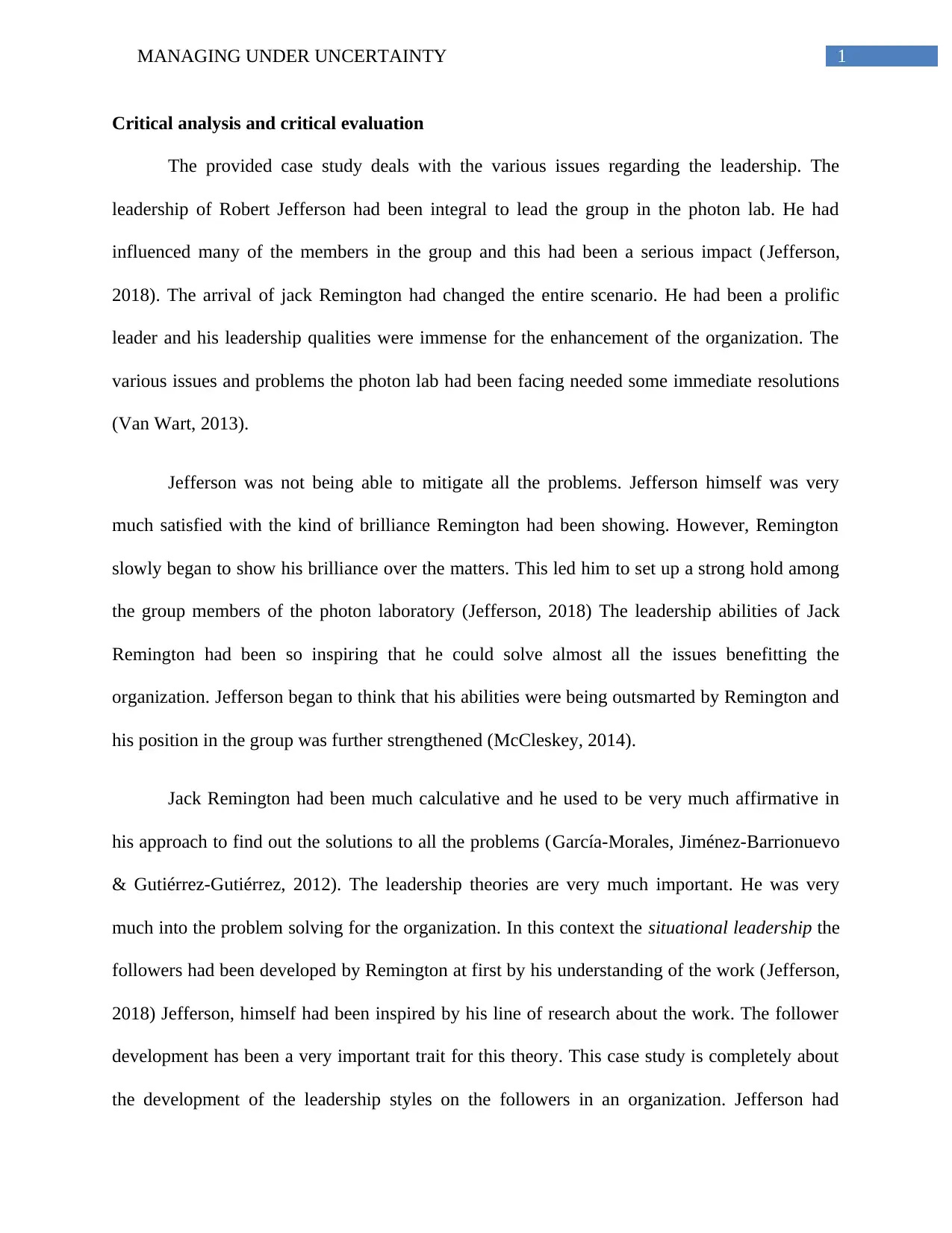
1MANAGING UNDER UNCERTAINTY
Critical analysis and critical evaluation
The provided case study deals with the various issues regarding the leadership. The
leadership of Robert Jefferson had been integral to lead the group in the photon lab. He had
influenced many of the members in the group and this had been a serious impact (Jefferson,
2018). The arrival of jack Remington had changed the entire scenario. He had been a prolific
leader and his leadership qualities were immense for the enhancement of the organization. The
various issues and problems the photon lab had been facing needed some immediate resolutions
(Van Wart, 2013).
Jefferson was not being able to mitigate all the problems. Jefferson himself was very
much satisfied with the kind of brilliance Remington had been showing. However, Remington
slowly began to show his brilliance over the matters. This led him to set up a strong hold among
the group members of the photon laboratory (Jefferson, 2018) The leadership abilities of Jack
Remington had been so inspiring that he could solve almost all the issues benefitting the
organization. Jefferson began to think that his abilities were being outsmarted by Remington and
his position in the group was further strengthened (McCleskey, 2014).
Jack Remington had been much calculative and he used to be very much affirmative in
his approach to find out the solutions to all the problems (García-Morales, Jiménez-Barrionuevo
& Gutiérrez-Gutiérrez, 2012). The leadership theories are very much important. He was very
much into the problem solving for the organization. In this context the situational leadership the
followers had been developed by Remington at first by his understanding of the work (Jefferson,
2018) Jefferson, himself had been inspired by his line of research about the work. The follower
development has been a very important trait for this theory. This case study is completely about
the development of the leadership styles on the followers in an organization. Jefferson had
Critical analysis and critical evaluation
The provided case study deals with the various issues regarding the leadership. The
leadership of Robert Jefferson had been integral to lead the group in the photon lab. He had
influenced many of the members in the group and this had been a serious impact (Jefferson,
2018). The arrival of jack Remington had changed the entire scenario. He had been a prolific
leader and his leadership qualities were immense for the enhancement of the organization. The
various issues and problems the photon lab had been facing needed some immediate resolutions
(Van Wart, 2013).
Jefferson was not being able to mitigate all the problems. Jefferson himself was very
much satisfied with the kind of brilliance Remington had been showing. However, Remington
slowly began to show his brilliance over the matters. This led him to set up a strong hold among
the group members of the photon laboratory (Jefferson, 2018) The leadership abilities of Jack
Remington had been so inspiring that he could solve almost all the issues benefitting the
organization. Jefferson began to think that his abilities were being outsmarted by Remington and
his position in the group was further strengthened (McCleskey, 2014).
Jack Remington had been much calculative and he used to be very much affirmative in
his approach to find out the solutions to all the problems (García-Morales, Jiménez-Barrionuevo
& Gutiérrez-Gutiérrez, 2012). The leadership theories are very much important. He was very
much into the problem solving for the organization. In this context the situational leadership the
followers had been developed by Remington at first by his understanding of the work (Jefferson,
2018) Jefferson, himself had been inspired by his line of research about the work. The follower
development has been a very important trait for this theory. This case study is completely about
the development of the leadership styles on the followers in an organization. Jefferson had
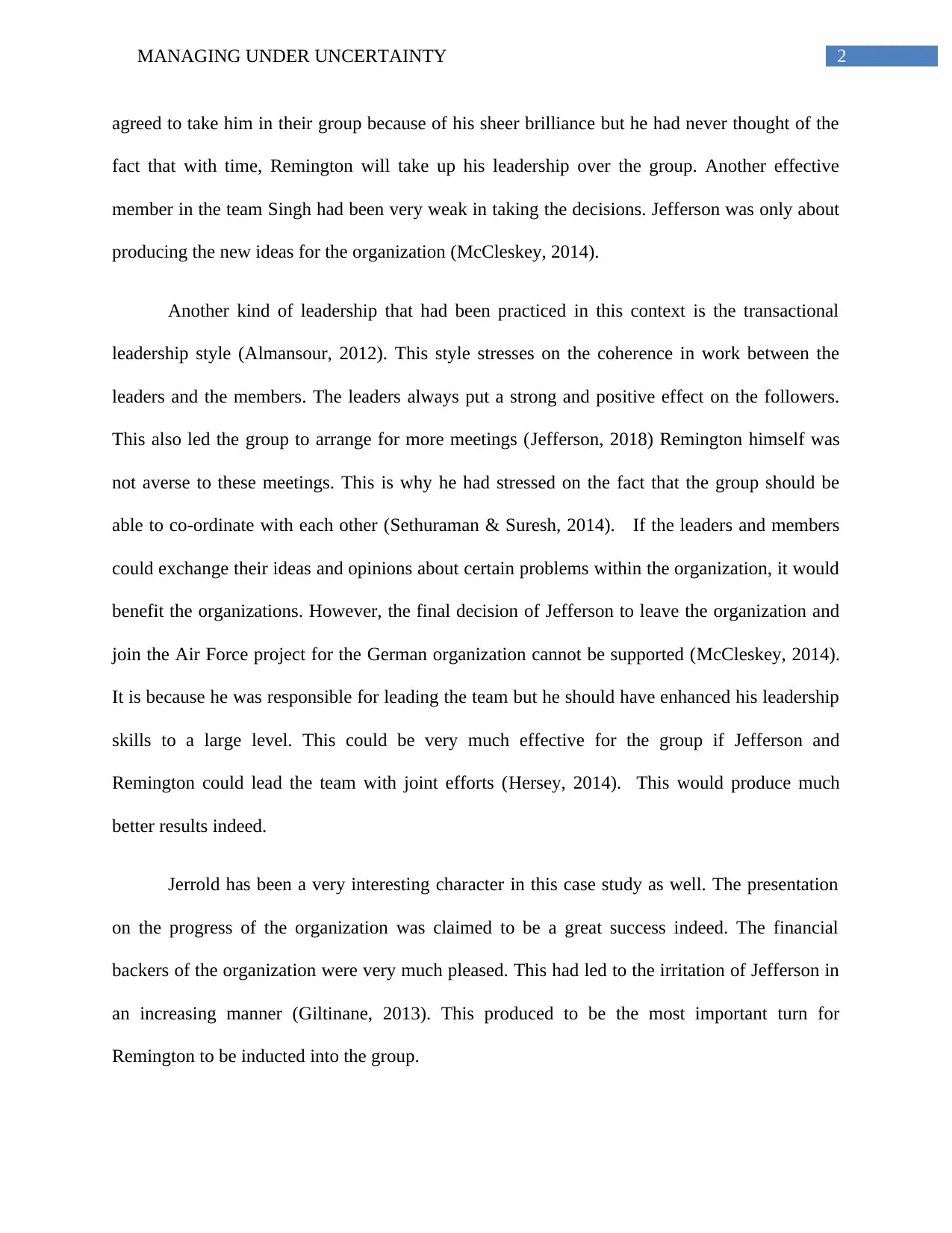
2MANAGING UNDER UNCERTAINTY
agreed to take him in their group because of his sheer brilliance but he had never thought of the
fact that with time, Remington will take up his leadership over the group. Another effective
member in the team Singh had been very weak in taking the decisions. Jefferson was only about
producing the new ideas for the organization (McCleskey, 2014).
Another kind of leadership that had been practiced in this context is the transactional
leadership style (Almansour, 2012). This style stresses on the coherence in work between the
leaders and the members. The leaders always put a strong and positive effect on the followers.
This also led the group to arrange for more meetings (Jefferson, 2018) Remington himself was
not averse to these meetings. This is why he had stressed on the fact that the group should be
able to co-ordinate with each other (Sethuraman & Suresh, 2014). If the leaders and members
could exchange their ideas and opinions about certain problems within the organization, it would
benefit the organizations. However, the final decision of Jefferson to leave the organization and
join the Air Force project for the German organization cannot be supported (McCleskey, 2014).
It is because he was responsible for leading the team but he should have enhanced his leadership
skills to a large level. This could be very much effective for the group if Jefferson and
Remington could lead the team with joint efforts (Hersey, 2014). This would produce much
better results indeed.
Jerrold has been a very interesting character in this case study as well. The presentation
on the progress of the organization was claimed to be a great success indeed. The financial
backers of the organization were very much pleased. This had led to the irritation of Jefferson in
an increasing manner (Giltinane, 2013). This produced to be the most important turn for
Remington to be inducted into the group.
agreed to take him in their group because of his sheer brilliance but he had never thought of the
fact that with time, Remington will take up his leadership over the group. Another effective
member in the team Singh had been very weak in taking the decisions. Jefferson was only about
producing the new ideas for the organization (McCleskey, 2014).
Another kind of leadership that had been practiced in this context is the transactional
leadership style (Almansour, 2012). This style stresses on the coherence in work between the
leaders and the members. The leaders always put a strong and positive effect on the followers.
This also led the group to arrange for more meetings (Jefferson, 2018) Remington himself was
not averse to these meetings. This is why he had stressed on the fact that the group should be
able to co-ordinate with each other (Sethuraman & Suresh, 2014). If the leaders and members
could exchange their ideas and opinions about certain problems within the organization, it would
benefit the organizations. However, the final decision of Jefferson to leave the organization and
join the Air Force project for the German organization cannot be supported (McCleskey, 2014).
It is because he was responsible for leading the team but he should have enhanced his leadership
skills to a large level. This could be very much effective for the group if Jefferson and
Remington could lead the team with joint efforts (Hersey, 2014). This would produce much
better results indeed.
Jerrold has been a very interesting character in this case study as well. The presentation
on the progress of the organization was claimed to be a great success indeed. The financial
backers of the organization were very much pleased. This had led to the irritation of Jefferson in
an increasing manner (Giltinane, 2013). This produced to be the most important turn for
Remington to be inducted into the group.
⊘ This is a preview!⊘
Do you want full access?
Subscribe today to unlock all pages.

Trusted by 1+ million students worldwide
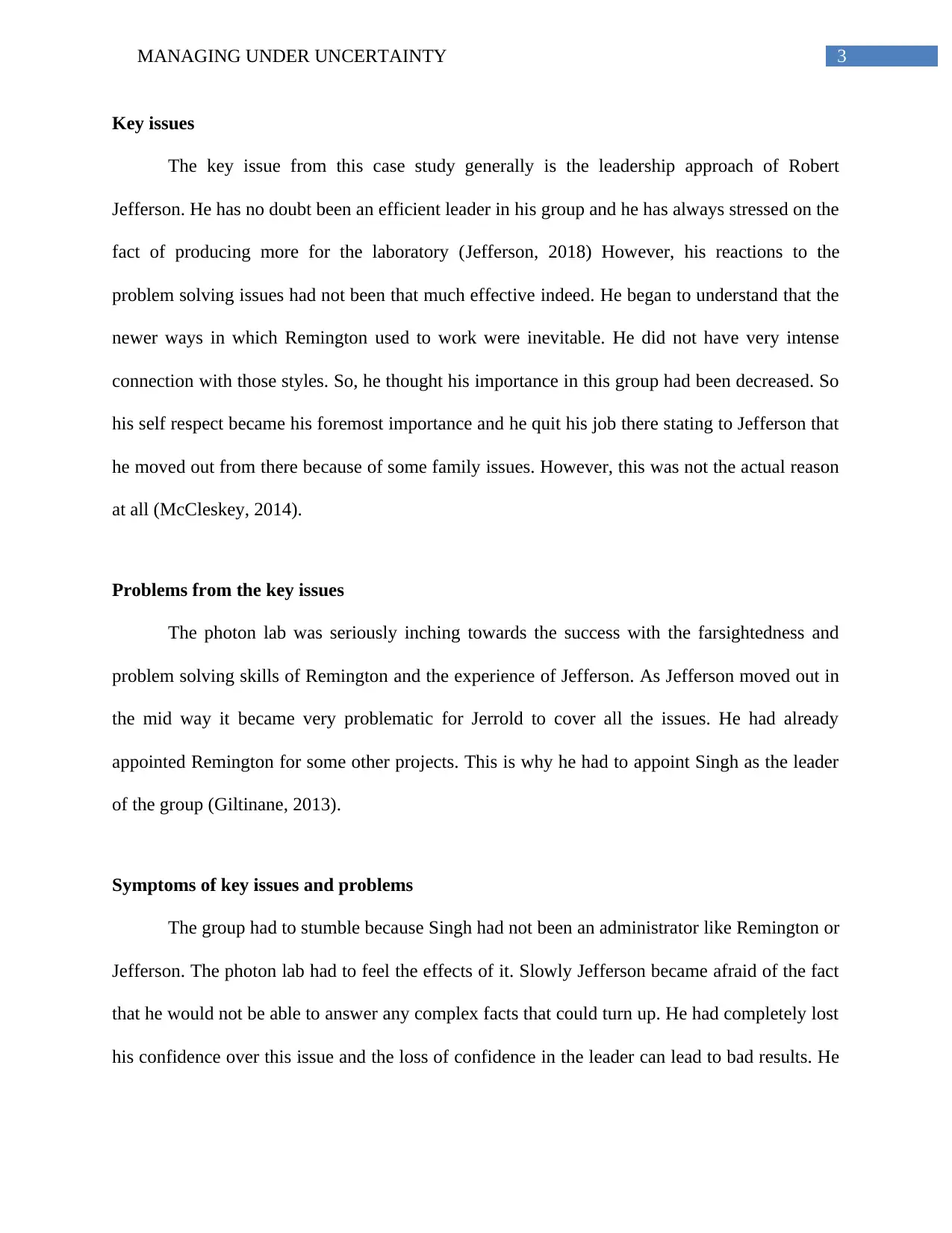
3MANAGING UNDER UNCERTAINTY
Key issues
The key issue from this case study generally is the leadership approach of Robert
Jefferson. He has no doubt been an efficient leader in his group and he has always stressed on the
fact of producing more for the laboratory (Jefferson, 2018) However, his reactions to the
problem solving issues had not been that much effective indeed. He began to understand that the
newer ways in which Remington used to work were inevitable. He did not have very intense
connection with those styles. So, he thought his importance in this group had been decreased. So
his self respect became his foremost importance and he quit his job there stating to Jefferson that
he moved out from there because of some family issues. However, this was not the actual reason
at all (McCleskey, 2014).
Problems from the key issues
The photon lab was seriously inching towards the success with the farsightedness and
problem solving skills of Remington and the experience of Jefferson. As Jefferson moved out in
the mid way it became very problematic for Jerrold to cover all the issues. He had already
appointed Remington for some other projects. This is why he had to appoint Singh as the leader
of the group (Giltinane, 2013).
Symptoms of key issues and problems
The group had to stumble because Singh had not been an administrator like Remington or
Jefferson. The photon lab had to feel the effects of it. Slowly Jefferson became afraid of the fact
that he would not be able to answer any complex facts that could turn up. He had completely lost
his confidence over this issue and the loss of confidence in the leader can lead to bad results. He
Key issues
The key issue from this case study generally is the leadership approach of Robert
Jefferson. He has no doubt been an efficient leader in his group and he has always stressed on the
fact of producing more for the laboratory (Jefferson, 2018) However, his reactions to the
problem solving issues had not been that much effective indeed. He began to understand that the
newer ways in which Remington used to work were inevitable. He did not have very intense
connection with those styles. So, he thought his importance in this group had been decreased. So
his self respect became his foremost importance and he quit his job there stating to Jefferson that
he moved out from there because of some family issues. However, this was not the actual reason
at all (McCleskey, 2014).
Problems from the key issues
The photon lab was seriously inching towards the success with the farsightedness and
problem solving skills of Remington and the experience of Jefferson. As Jefferson moved out in
the mid way it became very problematic for Jerrold to cover all the issues. He had already
appointed Remington for some other projects. This is why he had to appoint Singh as the leader
of the group (Giltinane, 2013).
Symptoms of key issues and problems
The group had to stumble because Singh had not been an administrator like Remington or
Jefferson. The photon lab had to feel the effects of it. Slowly Jefferson became afraid of the fact
that he would not be able to answer any complex facts that could turn up. He had completely lost
his confidence over this issue and the loss of confidence in the leader can lead to bad results. He
Paraphrase This Document
Need a fresh take? Get an instant paraphrase of this document with our AI Paraphraser
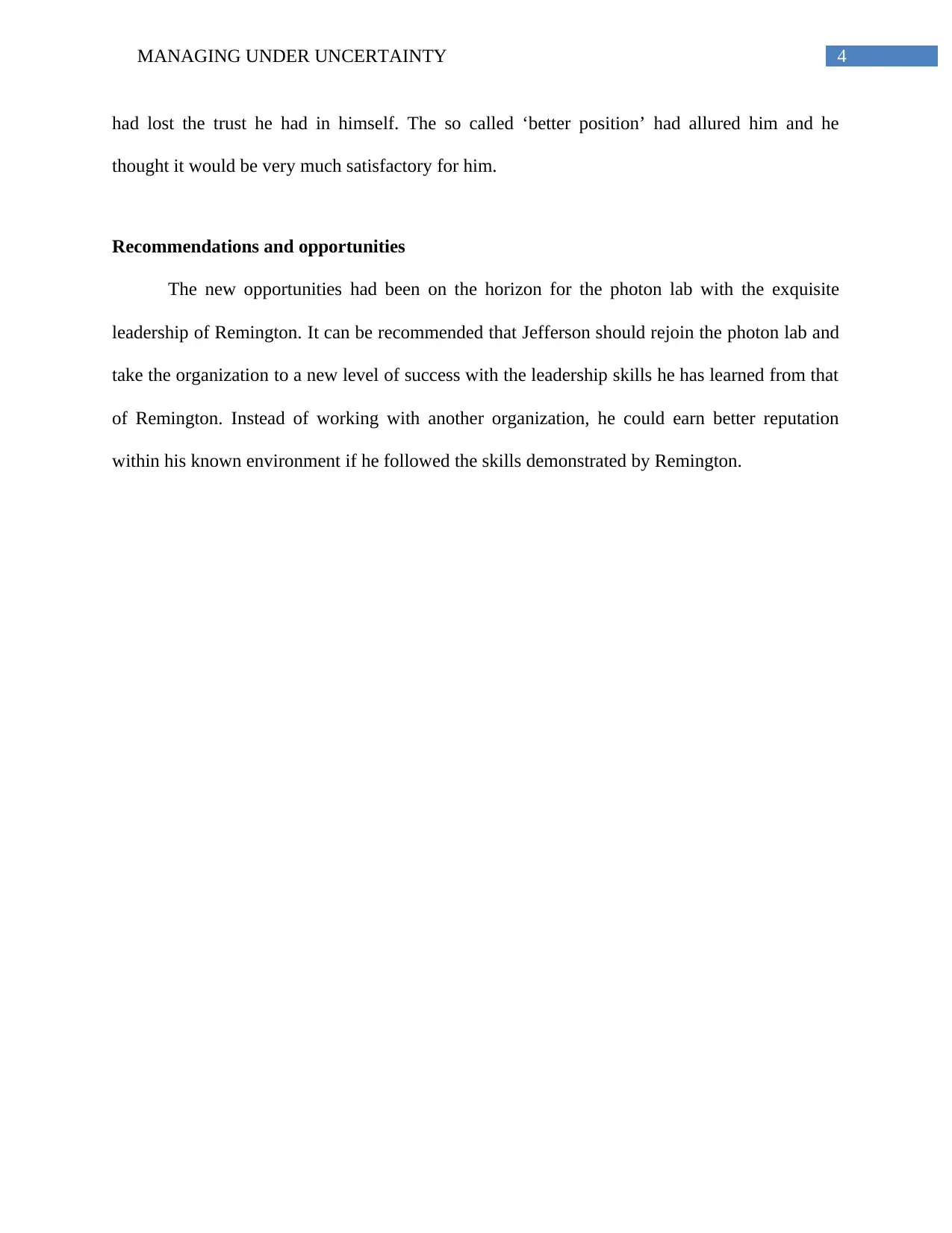
4MANAGING UNDER UNCERTAINTY
had lost the trust he had in himself. The so called ‘better position’ had allured him and he
thought it would be very much satisfactory for him.
Recommendations and opportunities
The new opportunities had been on the horizon for the photon lab with the exquisite
leadership of Remington. It can be recommended that Jefferson should rejoin the photon lab and
take the organization to a new level of success with the leadership skills he has learned from that
of Remington. Instead of working with another organization, he could earn better reputation
within his known environment if he followed the skills demonstrated by Remington.
had lost the trust he had in himself. The so called ‘better position’ had allured him and he
thought it would be very much satisfactory for him.
Recommendations and opportunities
The new opportunities had been on the horizon for the photon lab with the exquisite
leadership of Remington. It can be recommended that Jefferson should rejoin the photon lab and
take the organization to a new level of success with the leadership skills he has learned from that
of Remington. Instead of working with another organization, he could earn better reputation
within his known environment if he followed the skills demonstrated by Remington.
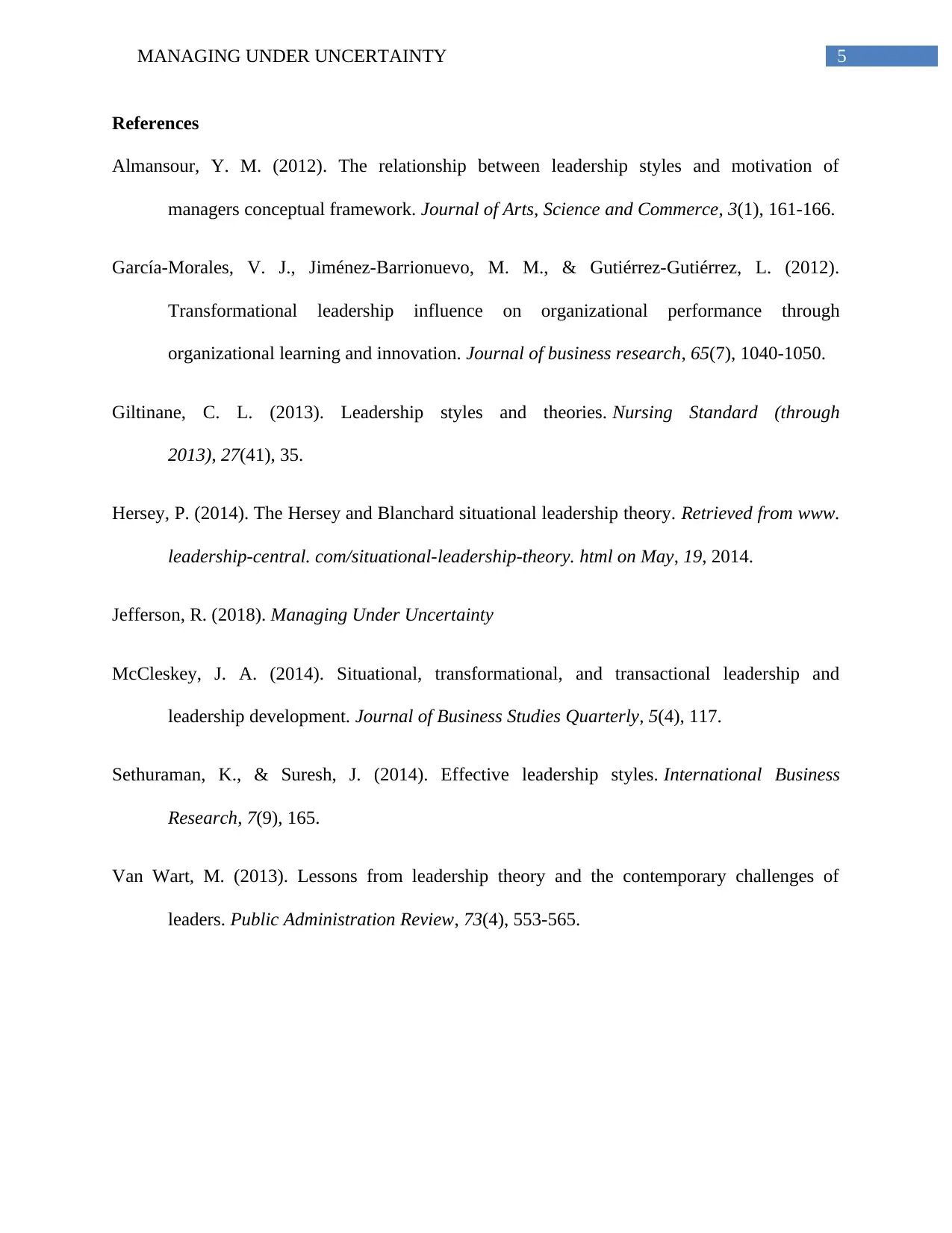
5MANAGING UNDER UNCERTAINTY
References
Almansour, Y. M. (2012). The relationship between leadership styles and motivation of
managers conceptual framework. Journal of Arts, Science and Commerce, 3(1), 161-166.
García-Morales, V. J., Jiménez-Barrionuevo, M. M., & Gutiérrez-Gutiérrez, L. (2012).
Transformational leadership influence on organizational performance through
organizational learning and innovation. Journal of business research, 65(7), 1040-1050.
Giltinane, C. L. (2013). Leadership styles and theories. Nursing Standard (through
2013), 27(41), 35.
Hersey, P. (2014). The Hersey and Blanchard situational leadership theory. Retrieved from www.
leadership-central. com/situational-leadership-theory. html on May, 19, 2014.
Jefferson, R. (2018). Managing Under Uncertainty
McCleskey, J. A. (2014). Situational, transformational, and transactional leadership and
leadership development. Journal of Business Studies Quarterly, 5(4), 117.
Sethuraman, K., & Suresh, J. (2014). Effective leadership styles. International Business
Research, 7(9), 165.
Van Wart, M. (2013). Lessons from leadership theory and the contemporary challenges of
leaders. Public Administration Review, 73(4), 553-565.
References
Almansour, Y. M. (2012). The relationship between leadership styles and motivation of
managers conceptual framework. Journal of Arts, Science and Commerce, 3(1), 161-166.
García-Morales, V. J., Jiménez-Barrionuevo, M. M., & Gutiérrez-Gutiérrez, L. (2012).
Transformational leadership influence on organizational performance through
organizational learning and innovation. Journal of business research, 65(7), 1040-1050.
Giltinane, C. L. (2013). Leadership styles and theories. Nursing Standard (through
2013), 27(41), 35.
Hersey, P. (2014). The Hersey and Blanchard situational leadership theory. Retrieved from www.
leadership-central. com/situational-leadership-theory. html on May, 19, 2014.
Jefferson, R. (2018). Managing Under Uncertainty
McCleskey, J. A. (2014). Situational, transformational, and transactional leadership and
leadership development. Journal of Business Studies Quarterly, 5(4), 117.
Sethuraman, K., & Suresh, J. (2014). Effective leadership styles. International Business
Research, 7(9), 165.
Van Wart, M. (2013). Lessons from leadership theory and the contemporary challenges of
leaders. Public Administration Review, 73(4), 553-565.
⊘ This is a preview!⊘
Do you want full access?
Subscribe today to unlock all pages.

Trusted by 1+ million students worldwide
1 out of 6
Related Documents
Your All-in-One AI-Powered Toolkit for Academic Success.
+13062052269
info@desklib.com
Available 24*7 on WhatsApp / Email
![[object Object]](/_next/static/media/star-bottom.7253800d.svg)
Unlock your academic potential
Copyright © 2020–2025 A2Z Services. All Rights Reserved. Developed and managed by ZUCOL.




